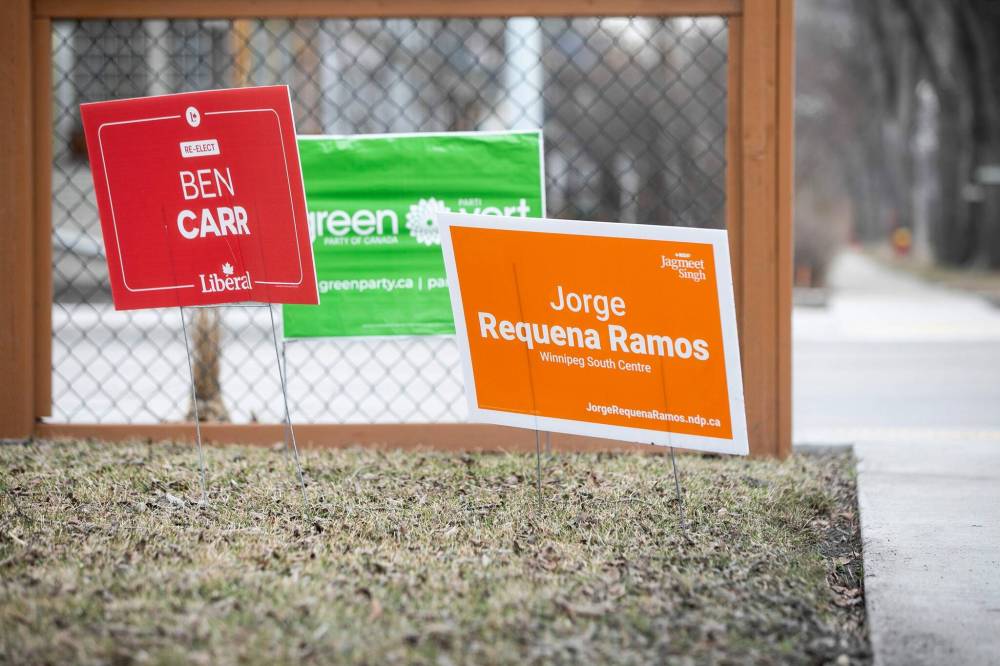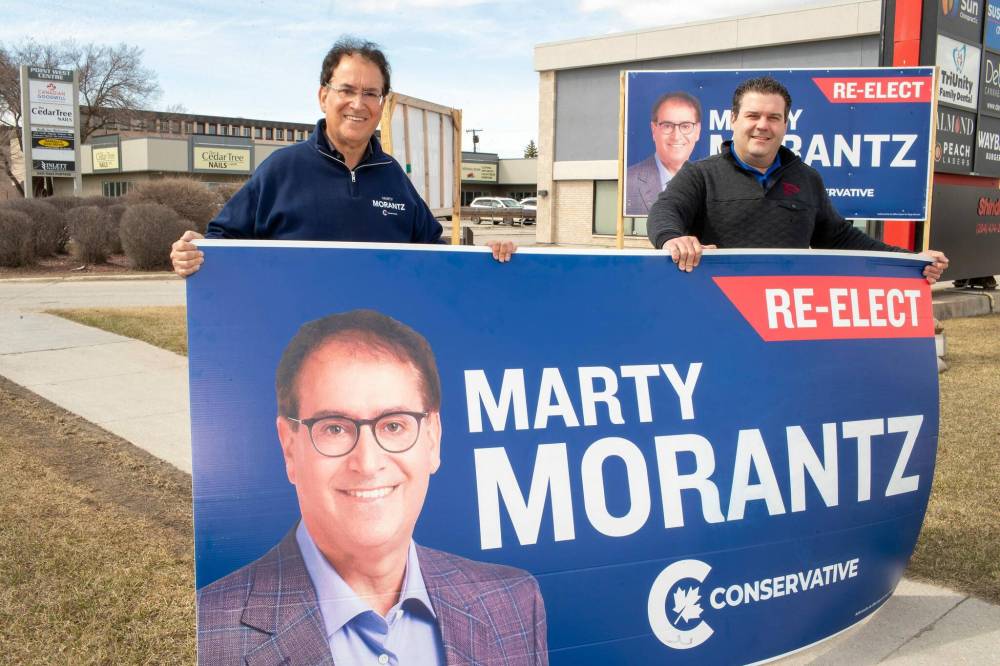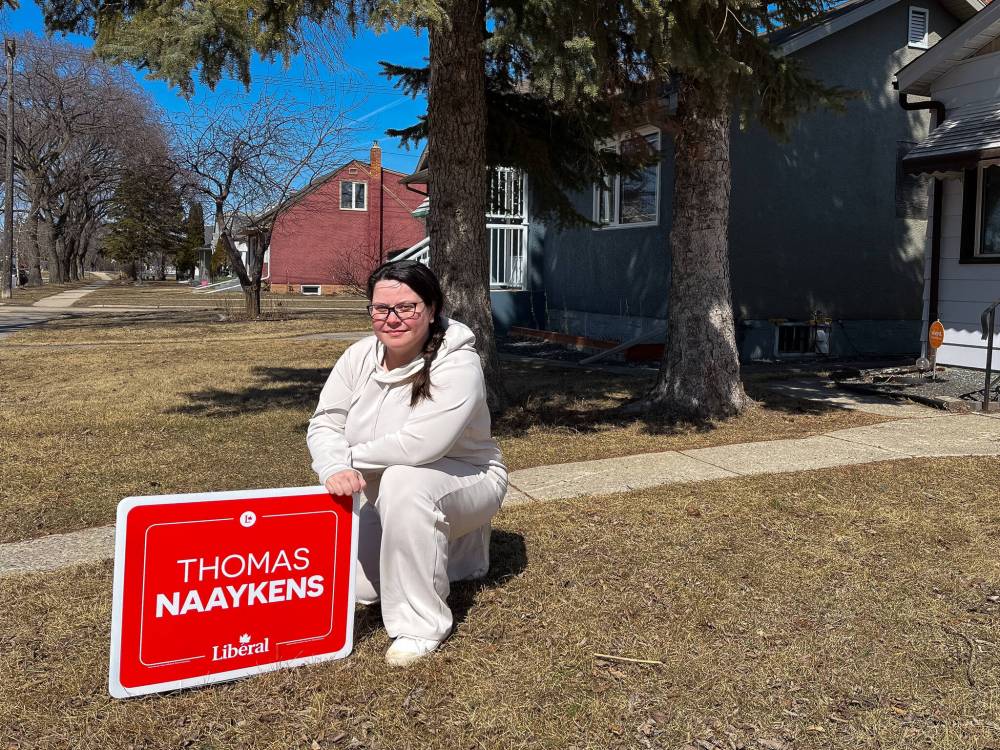Campaign vital signs
Despite accessibility of digital media, most candidates rely on old-fashioned political messaging
Advertisement
Read this article for free:
or
Already have an account? Log in here »
To continue reading, please subscribe:
Monthly Digital Subscription
$0 for the first 4 weeks*
- Enjoy unlimited reading on winnipegfreepress.com
- Read the E-Edition, our digital replica newspaper
- Access News Break, our award-winning app
- Play interactive puzzles
*No charge for 4 weeks then price increases to the regular rate of $19.95 plus GST every four weeks. Offer available to new and qualified returning subscribers only. Cancel any time.
Monthly Digital Subscription
$4.99/week*
- Enjoy unlimited reading on winnipegfreepress.com
- Read the E-Edition, our digital replica newspaper
- Access News Break, our award-winning app
- Play interactive puzzles
*Billed as $19.95 plus GST every four weeks. Cancel any time.
To continue reading, please subscribe:
Add Free Press access to your Brandon Sun subscription for only an additional
$1 for the first 4 weeks*
*Your next subscription payment will increase by $1.00 and you will be charged $16.99 plus GST for four weeks. After four weeks, your payment will increase to $23.99 plus GST every four weeks.
Read unlimited articles for free today:
or
Already have an account? Log in here »
Hey there, time traveller!
This article was published 22/04/2025 (263 days ago), so information in it may no longer be current.
When the federal election was called last month, candidates across Canada quickly arranged to have lawn signs printed and placed in willing supporters’ yards.
The timing wasn’t ideal for campaign managers in Manitoba. While the calendar suggested spring had sprung, the still-mostly frozen grass and dirt appearing where snow and ice had been didn’t offer much in the way of solid footing for the wire stakes that offer support of a different kind for the signs.
To make matters worse, the Manitoba version of March madness — rain, wet snow and frequent blustery conditions — knocked down many of the placards campaign workers did find a way to plant.
Incumbent Conservative candidate Marty Morantz (left) holds a large re-elect campaign sign with his campaign manager Michael Kowalson.Michael Kowalson, who is managing Conservative incumbent Marty Morantz’s campaign efforts in Winnipeg West, laughs while thinking about it.
“We had to go out and invest in a bunch of drill bits and power drills,” he told the Free Press.
“We’d show up on your lawn, we’d have to drill a couple of holes and then stick the sign into those drilled holes… that problem, fortunately, has passed, but now I’ve got more drill bits than any of us will ever need in our lifetime.”
It’s one of those tricks of the trade that keep things moving. Kowalson, who has managed more than 20 campaigns, was an unsuccessful candidate for city council in 2010, has picked up a few lessons along the way.
For example, when there’s a winter election, volunteers should carry a bottle of water to pour around the sign stakes to freeze them in place.
Beyond weather-related concerns, for the uninitiated there wouldn’t seem to be a whole lot more to be concerned about with regard to the sign side of running for office. Candidates and those who’ve helped them along the way know better; there are myriad questions asked and answered before, during and after the race.
Do you recycle signs if the candidate has run in the riding before? Do you include the party logo or let the colour of the sign do the talking?
Like incumbent NDP MP Leah Gazan in Winnipeg Centre, do you slap a “re-elect” in the corner of a placard from a previous election? Like Kevin Lamoureux in Winnipeg North — who has some signs with photos of him and Prime Minister Mark Carney together — do you include some sort of “topper” that alludes to the candidate’s platform?
Does all of the the planning, care and consideration that go into such an old-fashioned aspect of the democratic process pay off in the end?
Kowalson is convinced that it does.
“The bottom line is, (election signs) work. And, this isn’t scientific, but a lot of times I’ve seen the person who wins the sign war does really well in the election.”– Michael Kowalson, campaign manager for Conservative incumbent Marty Morantz
“The bottom line is, they work. And, this isn’t scientific, but a lot of times I’ve seen the person who wins the sign war does really well in the election,” he said.
Kowalson said Morantz’s sign strategy is simply focused on name recognition and repetition. He wants voters to see his candidate’s name everywhere they go in the riding.
And the Tory’s supporters do, too — even more than usual, it seems. While he declined to offer an exact count, Kowalson said a “record number” of signs had been placed with about two weeks to go before election day, and the campaign was continuing to get between 30 and 50 requests every day.
He said he’s heard the same from other campaign managers this year. After the last federal election had to be run, largely, at a distance because of the COVID-19 pandemic, people are ready to connect with their candidates.
“You’ll find that many people who take lawn signs, they’ll vote in advance polls, they’ll come out and volunteer, they’ll donate, help spread the word to neighbours and family and friends,” he said. “Lawn signs are a real motivator experience, both for candidates and for supporters.”
Homeowners’ reasons for agreeing — or not — to display party signs vary. One constituent in Elmwood-Transcona who was pulling a sign out of her yard told the Free Press that her husband agreed to put it up without consulting her, and they were, in fact, both undecided voters.

Another in Winnipeg North said that because she lives on a corner with heavy traffic flow, she had been approached by all three major party candidates and agreed to put up all three signs. She declined to say who she was voting for.
Others, such as Eleanore Chestley, have remained loyal to a party for decades.
The retired physiotherapist and union member said she’s been putting NDP signs in her Elmwood-Transcona lawn for nearly every election over the past 30 years.
“They stand for working people,” Chestley, 77, said.
Elmwood-Transcona — much of which was called Winnipeg-Transcona from 1988 to 2004 and Winnipeg-Birds Hill from 1979-1988 — has been represented by the NDP for all but four of its 46 years (2011-2015). Chestley, who said the odd house on her usually all-orange street is sporting Tory blue this time, doesn’t expect the seat to flip.
“People should vote… I like (NDP Leader) Jagmeet Singh — I have his book somewhere — but I honestly don’t think he’s going to win. But the more support he has, the better,” she said.
Next door, to the north and west in Kildonan-St. Paul, Mindy McKenzie is voting in her first federal election as a homeowner. She wasted no time calling Liberal candidate Thomas Naaykens to get a sign put up in her lawn after the election was called.
Describing herself as politically involved from a young age, voting Liberal or NDP since she was 18, she joked that in high school, she’d coach her boyfriend to vote for a certain candidate.
Mindy McKenzie is a new homeowner putting up a lawn sign on her property for the first time.Now, she’s in a riding that has largely been represented by the Tories, but feels a change brewing in her neighbourhood.
“I think there is kind of a shift and just a little bit more awareness that we are, maybe, not necessarily as affluent as others,” said McKenzie, 38. ‘We’re pretty middle-class here, in this little section, that you are voting against your interests when you’re voting for parties that are toeing the Conservative line.”
The riding has existed for less than 20 years, built from three surrounding ridings. It was represented by Conservative Joy Smith from its inception in 2004 until 2015, who spent much of her federal career focused on the single issue of fighting human trafficking. After a single Liberal term from 2015 to 2019 in the red-wave election that Justin Trudeau rode to the Prime Minister’s Office, Tory Raquel Dancho has been the MP since.
McKenzie’s street is peppered with signs from the three major parties, and while everyone is neighbourly and kind, she said she wanted to do her part to make her opposition to the incumbent’s party clear.
“When you’re looking at our current political landscape, there’s so much uncertainty and a lot of threat coming from the (U.S. President Donald) Trump administration and everything going on with America right now,” she said.
“I can’t see myself aligning with a party at all that would align themselves with that kind of rhetoric — the racism, the threat to women’s rights, the threat to trans rights — it’s just overwhelming.”
Moving into the inner city, one woman told the Free Press she knows that she’s one of the only homeowners in Winnipeg Centre with a Conservative sign out front.
She’s proud of “going against the grain” and marking her support for candidate Thomas Bambrick, but asked her name not be published — she works as a house cleaner, and speaking openly about her political views in the past was a mistake in the largely NDP-leaning community, she said.
“I got reprimanded big time, I lost every single client I had,” she said.
“I can’t see myself aligning with a party at all that would align themselves with that kind of rhetoric… the racism, the threat to women’s rights, the threat to trans rights… it’s just overwhelming.”– Mindy McKenzie
She said she respects the NDP’s incumbent candidate Gazan, and has also voted Liberal in the past, but said the impact of COVID-19 and current cultural issues have changed her political views strongly enough to warrant requesting a sign, which could again impact her livelihood.
“The second you say, ‘make Canada great again,’ (people) are like, ‘Oh, you’re MAGA, you’re this, or that,’ and, no, for the last nine years, we’ve been run by Liberal government, and look at the mess we’re in,” she said.
“The economy, inflation, all that stuff. Trudeau made a heck of a mess, and we need major, major change.”
Some of the candidates running for other parties don’t put in the same sign effort.
Gary Gervais delivering the Green Party’s message in Winnipeg Centre. It’s not his first time campaigning on a grassroots budget — he noted that in 2006, when he ran for the same party in the same riding, his campaign manager was his father.
He’s distributed a few signs but decided against printing too many — many of his supporters don’t want to see the signs end up in the landfill, and it gives the party a chance to stand out in its own way, he said.
“Every party stands up and says, ‘We’re different’; well, you’re doing the exact same thing as everyone else,” he said.
“The Greens, whether it’s a resource issue or an actual strategy, we can say, ‘Well, we’re different. We’re not doing that.’”
He’s spent time in election cycles elsewhere in the world, and said lawn signs aren’t nearly as prevalent in some places. He lived in Japan for several years, where trucks with loudspeakers were a frequent sight and sound.
He said his strategy is focusing on postcards with a QR code linking to his platform, a choice he described as more productive than a sign with a name and a colour.
“We see it in our electoral process, because people have been doing it forever. But do you have to always do it forever? I don’t know,” he said.
“Do you have to play the game everyone else is playing, I guess is the question.”
malak.abas@freepress.mb.ca

Malak Abas is a city reporter at the Free Press. Born and raised in Winnipeg’s North End, she led the campus paper at the University of Manitoba before joining the Free Press in 2020. Read more about Malak.
Every piece of reporting Malak produces is reviewed by an editing team before it is posted online or published in print — part of the Free Press‘s tradition, since 1872, of producing reliable independent journalism. Read more about Free Press’s history and mandate, and learn how our newsroom operates.
Our newsroom depends on a growing audience of readers to power our journalism. If you are not a paid reader, please consider becoming a subscriber.
Our newsroom depends on its audience of readers to power our journalism. Thank you for your support.
History
Updated on Tuesday, April 22, 2025 1:26 PM CDT: Shortens subheadline



















